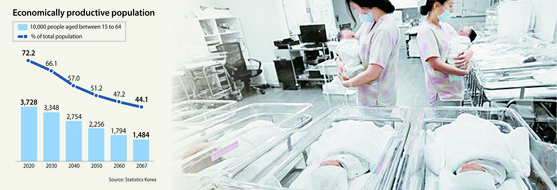Demographics look bad for working population

Korea’s economically productive population will fall more than 50 percent by 2060 if the current low birth rate lasts, the Korea Economic Research Institute said.
Korea's economically productive population, or those aged 15 to 64, amounted to 37 million this year. In 2060, the number is expected to be only about 18 million, 48.1 percent of the total this year.
According to Statistics Korea, the country's annual total fertility rate stood at 0.92 last year, the lowest in the world. The rate has been decreasing significantly since 2011, when it was at 1.24.
The total fertility rate is the average number of children borne by women aged 15 to 49.
The number of young people aged 6 to 21 is expected to dwindle to 42.8 percent of the total this year, according to the Korea Economic Research Institute (KERI), a research body run by the Federation of Korean Industries.
Korea’s age dependency ratio, or the ratio of dependents — people younger than 15 or older than 64 — to the working-age population has been sharply increasing.
In 2017, 36.7 people younger than 15 or older than 64 depended on 100 working people. However, in 2060, when this year’s newborn babies turn 40, there will be 98 dependents per 100 working people.
In other words, the working age population in 2060 will have to take care of nearly three times as many dependents as today.
As a part of efforts to tackle Korea’s plummeting birthrate, KERI advised more cash handouts.
Of all the money Korea has spent to combat the declining birthrate, cash handouts only accounted for 14.3 percent as of 2015. Compared with other Organisation for Economic Cooperation and Development (OECD) countries, whose average stood at 50.9 percent, Korea is second to the last.
In France, for instance, parents receive 295 euros ($342) per child per month until children turn 20, as well as a 952.08-euro birth grant for each newborn. A daily parental attendance allowance is also paid to any parent looking after a child under 20 who is suffering from a disease or severe handicap requiring constant assistance. The government gives parents 44.05 euros for each day they can't work due to their children's illnesses.
The average fertility rate of 15 OECD countries that are giving cash handouts above the average for the group stood at 1.56.
“While parents in foreign countries can feel the government’s help right away as they receive cash handouts, the Korean government is not using its budget effectively as it prefers to spend it in indirect ways such as tax breaks,” said Lee Sang-ho, a researcher at KERI.
KERI also advised Korea to come up with measures that can improve the enrollment rates of public pre-kindergartens.
While Korean parents receive smaller cash handouts from the government, they spend more for their children’s education. Last year, only 21.9 percent of all children in Korea enrolled at public pre-kindergartens, a third of the OECD average of 66.4 percent.
Low labor flexibility is another problem that needs to be tackled.
According to an analysis comparing 22 OECD countries whose per-capita GDP surpassed $30,000 as of 2018, the fertility rate of a nation is likely to rise as they have greater market flexibility.
“Encouraging women’s participation in a workforce by implementing flexible working hour systems will help increase the birth rate in Korea,” said a spokesperson for KERI.
BY LEE SO-AH, CHEA SARAH [chea.sarah@joongang.co.kr]










with the Korea JoongAng Daily
To write comments, please log in to one of the accounts.
Standards Board Policy (0/250자)